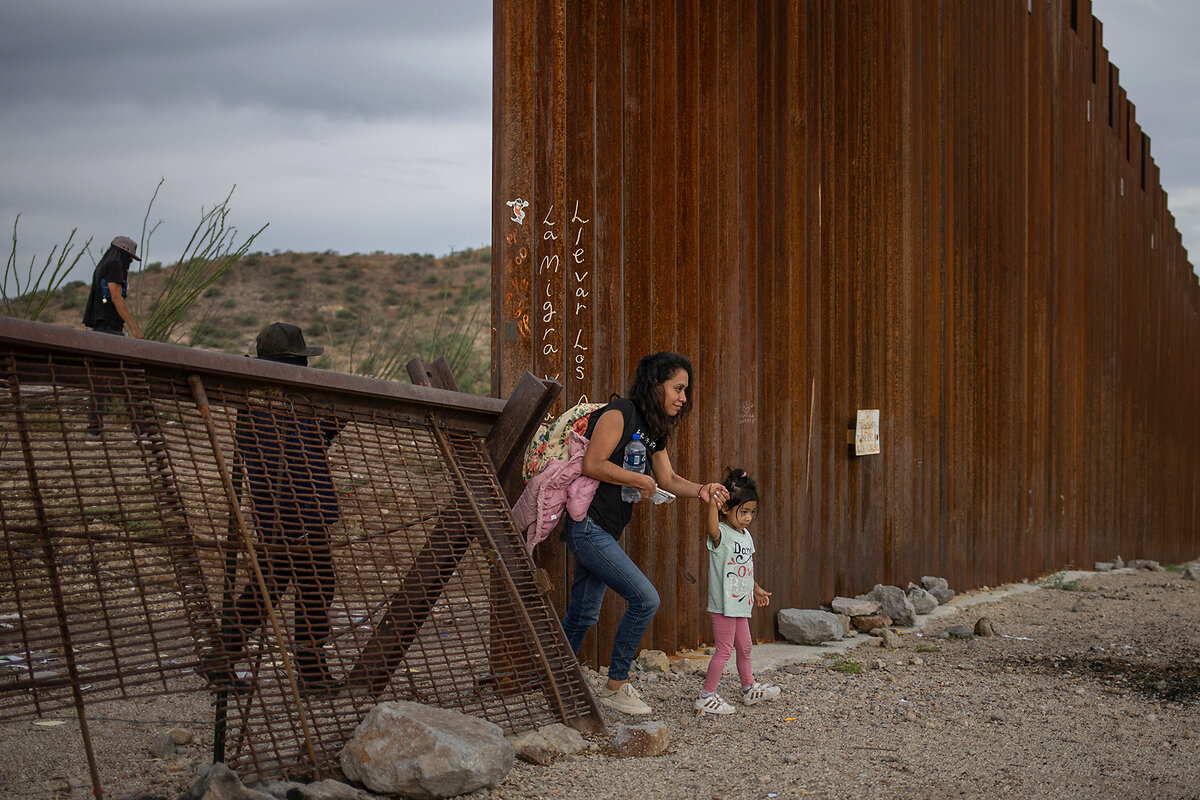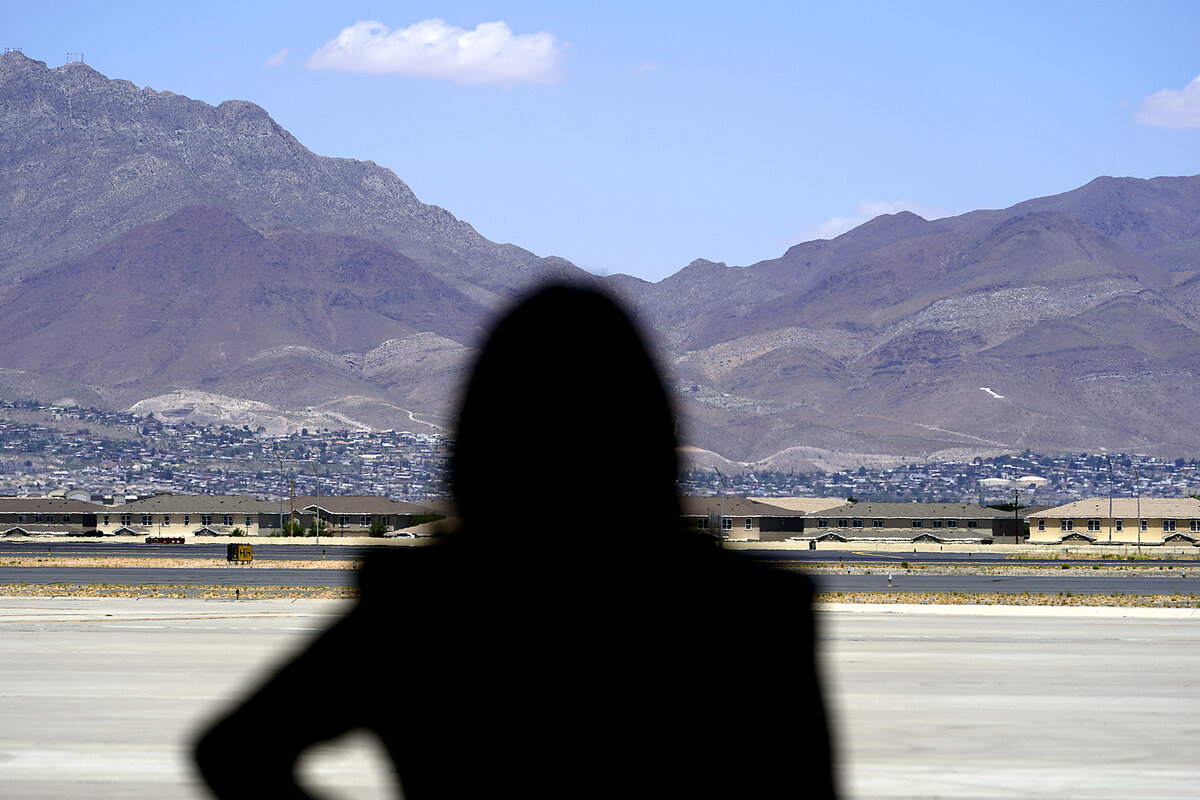What you need to know about Kamala Harris’ border security record
Loading...
U.S. Vice President Kamala Harris has unified her party behind her presidential candidacy. Yet she’s also inheriting major political problems – record levels of illegal border crossings in recent years and a broken immigration system. The Republican Party paints those as largely the failure of the current White House.
That includes claims that Ms. Harris served as President Joe Biden’s “border czar.” House Republicans and six Democrats approved a symbolic resolution on Thursday that reiterates the controversial title and condemns Ms. Harris for failing to secure the border.
Why We Wrote This
As Vice President Kamala Harris launches her presidential bid, opponents link her to unpopular Biden administration border policies. We untangle the debate over her immigration tasks.
Mr. Biden tasked the vice president, in 2021, with a diplomatic role to address the causes of migration from Mexico and Central America and to work with those countries to strengthen migration enforcement at their own borders.
Following that announcement, some Republicans began to dub Ms. Harris the “border czar.” Several media outlets also began to apply the moniker to the vice president. On Wednesday, Axios posted an editor’s note saying it had “incorrectly” used the term previously.
Remedying a long-failed immigration system, amid historically high migration globally, “takes an all-of-government, multiadministration commitment,” says Angela Kelley, former senior counselor for immigration and the border at the Department of Homeland Security.
Not even a week into her sudden candidacy for the White House, Vice President Kamala Harris appears to be facing more attacks on one issue than on any other: the southern border crisis during the Biden presidency.
Since President Joe Biden on Sunday stepped out of the presidential race, Ms. Harris has unified her party behind her candidacy. Yet Republicans have immediately pounced on immigration as a vulnerability for her. They cite record levels of illegal border crossings in recent years and a broken immigration system. The GOP paints those as largely the failure of the current White House.
Critics point to the claim that Ms. Harris served as the president’s “border czar” and failed. House Republicans and six Democrats approved a symbolic resolution Thursday that reiterates the controversial title and condemns the administration, and Ms. Harris in particular, for failing to safeguard the border against unauthorized immigrants and national security threats. But the meaning of her role on the issue is more nuanced.
Why We Wrote This
As Vice President Kamala Harris launches her presidential bid, opponents link her to unpopular Biden administration border policies. We untangle the debate over her immigration tasks.
Was Kamala Harris the “border czar”?
In 2021, President Biden did task the vice president with a diplomatic role to address the causes of migration from Mexico and Central America – such as violence and political instability – and to work with those countries to strengthen migration enforcement at their own borders. The assignment was similar to one Mr. Biden received as vice president in the Obama White House.
At the time, President Biden said he asked the vice president “to lead our efforts with Mexico and the Northern Triangle and the countries that help – are going to need help in stemming the movement of so many folks, stemming the migration to our southern border.”
Following Mr. Biden’s announcement, Texas Republicans began to dub Ms. Harris the “border czar.” Several media outlets also began to apply the moniker. On Wednesday, Axios posted an editor’s note saying it had “incorrectly” used the term previously. Neither the Department of Homeland Security nor a White House spokesperson responded to Monitor requests seeking to clarify Ms. Harris’ role.
The term “czar” has been used by the media and policymakers for decades to describe certain government officials, especially as a quick substitute for complicated official titles. Franklin D. Roosevelt had a czar for shipping during World War II, Richard Nixon had an “energy czar” in the 1970s, and George W. Bush and Barack Obama both had over 30 officials in their administrations dubbed with that term, writes Tom Shoop, former editor-in-chief of Government Executive Media Group.
“The use of the term is somewhat squishy, because it’s never been an official designation,” Mr. Shoop says in an article last year about how the Russian word became applied to U.S. officials.
Nonetheless, the Republican line of attack is clear.
“If she becomes president, Kamala Harris will make the invasion exponentially worse,” former President Donald Trump said Tuesday on a call with reporters. “I will terminate every open-borders policy of the Biden-Harris administration.”
Mr. Biden departs the race just as monthly Border Patrol encounters with migrants along the southern border dropped in June to their lowest level since his first month in office. The White House credits new restrictions around entry and asylum access enacted last month, along with more enforcement in Mexico.
Angela Kelley, former senior counselor for immigration and the border at the Department of Homeland Security during the first two years of the Biden administration, says remedying a long-failed immigration system isn’t just the job of one person. Amid historically high migration globally, she says it “takes an all-of-government, multiadministration commitment.”
What was her role on the U.S. southern border?
The level of Ms. Harris’ involvement with immigration policy at the southern border is under debate. Though influenced by executive action, immigration enforcement is largely carried out by the Department of Homeland Security, whose secretary, Alejandro Mayorkas, House Republicans impeached this year.
In April 2021, shortly after Mr. Biden’s announcement of her immigration role, Ms. Harris drew a line between her task and that of Secretary Mayorkas.
“The President has asked Secretary Mayorkas to address what is going on at the border, and he has been working very hard and is showing some progress because of his hard work. I have been asked to lead the issue of addressing the root causes,” she said in response to a reporter’s question. She added that those causes “are not issues that are going to be addressed overnight.”
In June 2021, Ms. Harris visited Mexico and Guatemala. Her message to migrants? “Do not come,” she said in Guatemala City. “Do not come.”
Migrants would, however, continue to come. That messaging had “very minimal effect,” says Theresa Cardinal Brown, senior adviser for immigration and border policy at the Bipartisan Policy Center. Similar statements have had “minimal effect from government officials for a long time,” she adds.
Immigrant advocates, meanwhile, were disappointed by Ms. Harris’ words. Under U.S. law, immigrants who enter illegally (between ports of entry) may still apply for asylum. Mr. Biden’s recent actions limiting asylum claims face lawsuits from immigrant rights groups.
How has Ms. Harris talked about the border?
A defensive interview with NBC News during her 2021 Guatemala trip brought Ms. Harris further criticism by Republicans and border Democrats for having not yet visited the U.S. southern border.
Within the month, the vice president went to the border at El Paso, Texas. As she visited immigration facilities and met young migrant girls, she framed the crisis in humanitarian terms.
The children reminded her, said Ms. Harris, “of the fact that this issue cannot be reduced to a political issue. We’re talking about children, we’re talking about families, we are talking about suffering.”
While migration from the Northern Triangle has declined, that hasn’t been enough to curb record-high illegal border crossings during the Biden administration overall, representing dozens of countries. No single factor can explain these dynamics, experts say. And while Ms. Harris announced more than $5.2 billion in private-sector commitments to Northern Triangle countries (Guatemala, Honduras, and El Salvador) as of this year, in part to create jobs, the status of those funds is unclear.
On Tuesday’s call with Mr. Trump, the former head of the Border Patrol union expressed frustration with the White House.
“Instead of addressing cartels and the human devastation they cause to migrants and U.S. citizens alike, she tried to explain away the crisis as a climate and political instability issue,” said Brandon Judd, former president of the National Border Patrol Council.
While conservative critics say the loosening of Trump-era border restrictions attracted more migrants, the White House lays blame on gridlocked Congress.
“We are very clear, and I think most Americans are clear, that we have a broken immigration system and we need to fix it,” Ms. Harris told ABC News in March. She blamed Senate Republicans for rejecting a bipartisan border security deal after Mr. Trump disparaged it.
“The former president would prefer to run on a problem than fix a problem,” she said.
How have her immigration views evolved?
Her public service began in California, a border state with the nation’s largest foreign-born population. After serving as district attorney of San Francisco beginning in 2004, Ms. Harris was elected state attorney general in 2010.
Ms. Harris advocated for immigrant victims of crimes, and held mixed positions on what are often called “sanctuary policies.” While district attorney, she approved of local law enforcement working with federal authorities on arrests of juvenile unauthorized immigrants. Later, as attorney general, she advised that complying with requests by Immigration and Customs Enforcement (ICE) regarding unauthorized immigrants was voluntary for local officials.
The Californian went on to serve in the U.S. Senate from 2017 to January 2021. There she advocated for “Dreamers,” unauthorized immigrants who were brought to the United States as children. She challenged the Trump administration’s family separation policies, made a call to “critically reexamine ICE,” and disapproved of Mr. Trump’s attempts to build more border wall.
“I am a strong believer in border security,” she wrote in her memoir, “but experts agree that a wall will not secure our border.” She also argued that funding could be better spent on the opioid crisis, rural broadband, and critical infrastructure.










